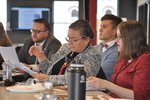

In a public service announcement addressed to the “citizens of Crawfordsville,” Wabash College students rattle off numbers about the billions of federal dollars made possible by the U.S. Census.
Pointing to the camera, the young men declare, “Your participation in the census matters.”
The PSA is among a gallery of videos, brochures and other materials posted online in an effort to raise awareness of the once-in-a-decade tally, especially among Hispanics and homeless people who are historically undercounted. Students officially launched the website Tuesday during an event at Fusion 54.
As part of a class on the census, students worked with city leaders and various community agencies to strategize reaching out to people at risk of going uncounted. For the first time, the census is largely taking place on the Web, raising concerns for populations with unreliable or no internet or computer access who are given the option of being counted by phone or mail.
“I knew [there] was a Census Bureau and I knew that it was kind of a big deal, but I didn’t know that so many government agencies and so many departments really have much to gain from the Census,” said freshman Jakob Goodwin of Indianapolis.
To get a more accurate population count, students encourage agencies to share the materials on social media and in schools and government offices. The collection includes handouts explaining when the census will be taken and the process of filling out the form, as well as how Montgomery County’s data could help companies scope out consumer demographics before deciding to move in or potentially boost school funding.
Some of the material is available in Spanish.
Census workers struggle to get an accurate count of Hispanic people due in part to fear the information will be handed over to immigration authorities, which is not the policy.
Father Chris Shocklee, pastor of St. Bernard Catholic Church whose parish includes Hispanic congregants, said the distrust is a barrier to filling out the form.
“I think a lot of it is just the encouragement and the reassurance that this is not being used for anything but the benefit of the community,” Shocklee said. “The more they can hear about the benefits that come from it and how it’s going to affect them directly, I think that will help a lot of the people here know that this is something they want to take part in, not something to try to avoid.”
LeAnnie Johnson of Pam’s Promise Transitional Housing, which provides non-emergency shelter to homeless men, women and children, asked about the procedure for counting homeless people.
“Do they have to have an address to be counted?” Johnson asked.
A Census Bureau partnership specialist who attended the presentation told Johnson that wasn’t the case. Instead, Census workers will fan out on a set day in February or March to count homeless people in areas where they’re known to congregate.